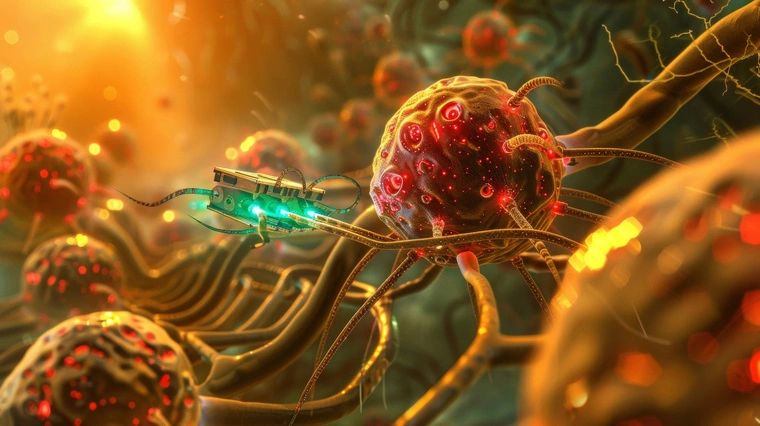Acclaimed futurist and computer scientist Raymond Kurzweil thinks humans are on the cusp of extending their lifespans to nearly a millennium through the merger of biotechnology, artificial intelligence, and nanobots.
Kurzweil, a recipient of the 1999 Presidential National Medal of Technology and Innovation, envisions a future where human longevity is drastically extended, potentially allowing individuals to live up to 1,000 years.
In his latest book, The Singularity is Nearer, and a recent essay published by Wired, Kurzweil outlines his belief that the convergence of new, disruptive technologies will lead to significant advancements in life extension, surpassing the oldest verified natural human lifespan limit of 122 years.
Kurzweil’s optimism is rooted in the advancements in nanotechnology, which he believes will play a crucial role in extending human life. According to him, this life extension process is divided into three distinct phases.
The first phase involves applying current pharmaceutical and nutritional knowledge to overcome health challenges. We are currently in the second phase of life extension, characterized by the merger of biotechnology with AI. By the 2030s, Kurzweil predicts that the third phase will commence, utilizing nanotechnology to transcend the limitations of biological organs entirely.
“But how will nanotechnology actually make this possible?” Kurzweil writes. “In my view, the long-term goal is medical nanobots.”
Nanobots, tiny robots that can operate at the molecular level, are central to Kurzweil’s vision of life extension. These microscopic machines could be designed to repair cellular damage, monitor health, and even replace biological functions. For instance, nanobots could repair tissues, destroy cancer cells, and enhance organ function, effectively preventing many age-related diseases.
A significant breakthrough in this field was achieved in 2020 when Stanford and Michigan State University researchers developed a “Trojan Horse” nanoparticle capable of targeting and eliminating cells that cause atherosclerotic plaque. The build of atherosclerotic plaque can lead to heart attack or stroke, a leading cause of death in the United States.
Such advancements provide a glimpse into the potential of nanotechnology in revolutionizing medical treatments and extending human life.
Kurzweil describes future medical nanobots as made from diamondoid parts and equipped with sensors, manipulators, computers, and communicators. Unlike conventional robots, these nanobots will navigate the body using principles suited to nanoscale environments, where fluid dynamics differ significantly from those at larger scales. They will harness energy from their surroundings and work collaboratively to achieve their tasks.
The human body comprises tens of trillions of cells, and Kurzweil envisions augmenting these cells with nanobots, potentially reaching hundreds of billions of nanobots per person.
These nanobots will repair and maintain organs and optimize bodily functions by regulating hormone levels, enhancing energy and focus, and improving natural healing processes.
As Kurzweil points out, his predictions about cellular nanobots are rooted in something other than science fiction. In a 1998 paper, nanotechnologist Robert Freitas provided the basis for a hypothetical, microscopic, artificial red blood cell that could supplement or replace the human respiratory system.
Freitas’ nanobot, dubbed a “respirocyte,” could allow individuals to hold their breath for up to four hours, showcasing the potential for nanobots to augment and even surpass natural human abilities.
Current technology cannot compensate for the necessary power, atomic-scale manipulation, computation, and communication to make respirocytes a reality. However, with the current pace of biotechnology advances, Kurzweil believes nanobots like the respirocyte will soon be a reality.
Integrating biotechnology and AI is a critical component of Kurzweil’s life extension framework. AI will play a pivotal role in understanding human biology at a deeper level, enabling precise interventions at the cellular level. This will allow for the early detection and prevention of diseases, as well as the optimization of bodily functions.
In his latest writings, Kurzweil also highlights the potential for AI to revolutionize genetic engineering. By gaining control over our genes and using AI to simulate and regulate gene expression, it will be possible to prevent and reverse the accumulation of DNA transcription errors, a significant cause of aging.
An outspoken advocate for transhumanism, Kurzweil believes that nanotechnology will have the most significant impact on the human brain. He predicts that human brains of the future will be “more than 99.9 percent nonbiological.”
This integration of nanobots and the brain will likely happen in two stages. The first stage involves gradually introducing nanobots to brain tissue to repair or replace damaged neurons. The second stage will include using microscopic computers to create “digital layers of neocortex” that will allow one to control machines through one’s thoughts and effectively connect the human brain to a massive cloud-based internet.
Kurzweil, a recipient of the United States’ highest honor in technology for “pioneering and innovative achievements in computer science” – the Presidential National Medal of Technology and Innovation- acknowledges that his predictions may seem far-fetched. However, he emphasizes that they are grounded in current scientific trends and technological advancements.
Kurzweil notes that the exponential growth in computing power and our increasing understanding of human biology make these projections plausible and highly likely.
The prospect of extending human life to nearly 1,000 years also raises ethical and societal questions. Concerns about overpopulation, resource allocation, and the implications of dramatically increased life spans all need to be addressed. However, Kurzweil argues that improving the quality of life and the potential to alleviate suffering make the pursuit of life extension a worthy goal.
Raymond Kurzweil’s vision of life extension through nanotechnology, biotechnology, and AI offers an exciting glimpse into a future where humans might live significantly longer lives.
Of course, this premonition of a future where the lines between technology and biology are blurred to indistinguishable raises grave and unsettling concerns.
Just this year, AI security experts have issued ominous warnings that there is no evidence that artificial intelligence can be controlled and that the development of artificial superintelligence could spell the end of humanity.
At a minimum, even if the technology exists in the next 5-10 years, these concerns should make us consider if we want to integrate AI into the human body.
For his part, Kurzweil has a much more optimistic view of the future and an era in which nanotechnology will give people the ability to have superhero-like powers.
“As nanotechnology takes off, we will be able to produce an optimized body at will: We’ll be able to run much faster and longer, swim and breathe under the ocean like fish, and even give ourselves working wings if we want them,” Kurzweil writes. “We will think millions of times faster, but most importantly, we will not be dependent on the survival of any of our bodies for ourselves to survive.”
Tim McMillan is a retired law enforcement executive, investigative reporter and co-founder of The Debrief. His writing typically focuses on defense, national security, the Intelligence Community and topics related to psychology. You can follow Tim on Twitter: @LtTimMcMillan. Tim can be reached by email: tim@thedebrief.org or through encrypted email: LtTimMcMillan@protonmail.com

